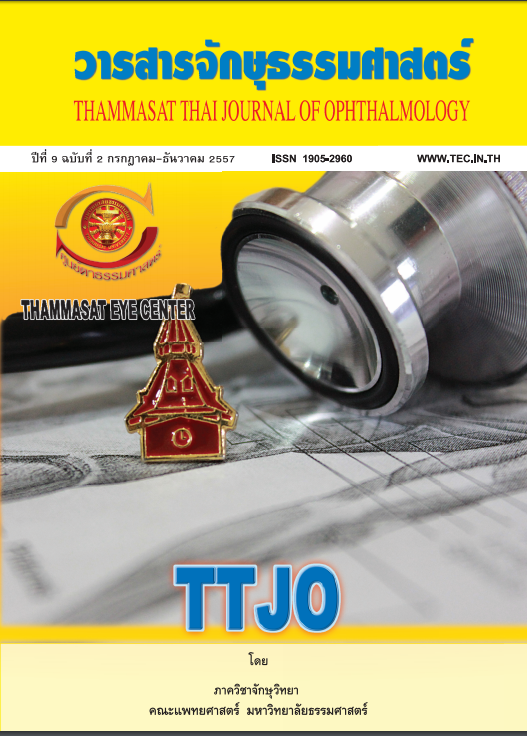ภาวะแก๊สในช่องหน้าวุ้นตาหลังการฉีดแก๊สเพื่อรักษาจอตาลอก
Main Article Content
Abstract
วัตถุประสงค์: เพื่อศึกษาอุบัติการณ์ของภาวะแก๊สใน ช่องหน้าวุ้นตาหลังการฉีดแก๊สเพื่อรักษาจอตาลอก รวมถึงการดำเนินโรค การรักษา และปัจจัยเสี่ยงต่อการ เกิดภาวะแก๊สในช่องหน้าวุ้นตา เพื่อนำไปสู่วิธีป้องกัน ที่เหมาะสม
รูปแบบการวิจัย: การศึกษาย้อนหลังเชิงพรรณนา
วิธีการวิจัย: รวบรวมประวัติการรักษาของผู้ที่เกิดภาวะ แก๊สในช่องหน้าวุ้นตาจากกลุ่มผู้ป่วยจอตาลอกที่ได้รับ การรักษาโดยการฉีดแก๊สในช่องวุ้นตา โดยเก็บข้อมูล ประวัติก่อนการรักษา ข้อมูลการฉีดแก๊ส ข้อมูลหลังการ ฉีดแก๊ส การดำเนินของโรค วิธีการรักษา และผลการ รักษาสุดท้าย แล้วนำผลดังกล่าวมาหาอุบัติการณ์ ปัจจัย เสี่ยง และสรุปการดำเนินโรคและผลการรักษาภาวะแก๊ส ในช่องหน้าวุ้นตา
ผลการวิจัย: จากการรวบรวมข้อมูลตั้งแต่ ธันวาคม 2552 ถึง ตุลาคม 2556 พบว่ามีผู้ป่วยจอตาลอกที่ได้รับการ รักษาโดยการฉีดแก๊สเข้าในช่องวุ้นตาทั้งสิ้น 258 คน โดยพบผู้ที่เกิดภาวะแก๊สในช่องหน้าวุ้นตา 2 คน คิดเป็น ร้อยละ 0.77 โดยทั้ง 2 คนพบว่าภาวะแก๊สในช่องหน้า วุ้นตาหายไปเองได้หลังจากแนะนำให้ผู้ป่วยนอนคว่ำหน้าที่ 6 สัปดาห์และ 4 วันหลังฉีดแก๊ส ตามลำดับ มีผู้ป่วย 1 คนที่ต้องได้รับการผ่าตัดอีก 2 ครั้งจอตาจึงติดดี ส่วนอีกคนจอตากลับมาติดได้หลังการฉีดแก๊สครั้งเดียวโดยไม่ต้องผ่าตัดเพิ่มเติม ผลการรักษาสุดท้ายจอตาติดดี ทั้ง 2 คนที่ระยะเวลา 5 เดือน และ 2 สัปดาห์หลังเริ่มการ รักษาตามลำดับ
สรุปผลการวิจัย: ภาวะแก๊สในช่องหน้าวุ้นตาหลังการ ฉีดแก๊ส ถึงแม้จะพบอุบัติการณ์เกิดขึ้นน้อย แต่ก็เป็น สาเหตุที่ทำให้การรักษาจอตาลอกนั้นล้มเหลวได้ แต่ ภาวะนี้สามารถหายไปได้เองโดยการให้ผู้ป่วยนอนคว่ำหน้า และสามารถป้องกันการเกิดภาวะดังกล่าวได้ด้วย วิธีการฉีดแก๊สที่ถูกต้อง
Anterior Hyaloid Gas Entrapment After Pneumatic Reti
Abstract
Objective: To observe the incidence of anterior hyaloid gas entrapment after pneumatic retinopexy in treatment of rhegmatogenous retinal detachment, including clinical presentation, management and risk factors.
Design: Descriptive retrospective study
Methods: Data of the patients with anterior hyaloid gas entrapment after pneumatic retinopexy in rhegmatogenous retinal detachment treatment were collected, including pre-operative data, type of injected gas and process of pneumatic retinopexy, post-operative disease presentation, management and final anatomical and visual outcome. The data were analyzed to explore the incidence, risk factors, disease progression, management and final treatment outcome.
Results: The data was collected from December 2009 to October 2013. In 258 cases of rhegmatogenous retinal detachment that treated with pneumatic retinopexy, there were two cases of anterior hyaloid gas
entrapment (0.77%). Anterior hyaloid gas can resolve spontaneously after advise the patients to maintain appropriate head position in all 2 cases at 6th week and 4th day after pneumatic retinopexy respectively. There was 1 case require 2 additional procedures (par plana vitrectomy) to reattach the retina. Attached retina after single pneumatic retinopexy procedure was found in one case. Final anatomical success was reached at the 5th month and 2nd week respectively after initial treatment.
Conclusions: Anterior hyaloid gas entrapment is not the common complication of pneumatic retinopexy, but is the importance cause of treatment failure. This condition will resolve spontaneously after maintain the appropiate head position. Anterior hyaloid gas entrapment can be prevented by appropiated and careful gas injection procedure.


